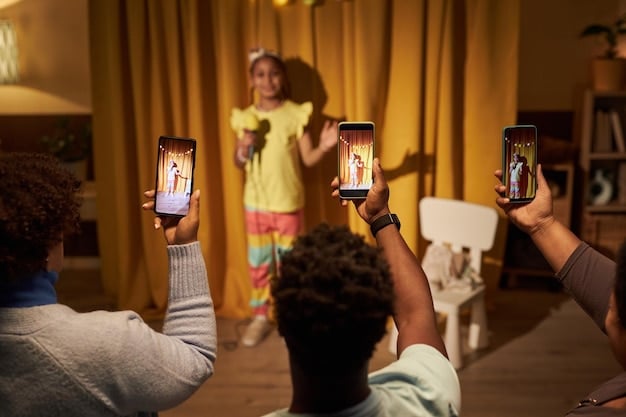The evolution of drama reviews: from print to digital landscapes

The evolving landscape of drama reviews encompasses a shift from traditional print criticism to dynamic digital platforms, influencing audience engagement, critical discourse, and the very perception of theatrical arts.
The world of dramatic arts has always been inextricably linked with its critical commentary. From ancient Greek choruses offering their interpretations to the insightful prose of modern-day critics, the analysis of theatrical performance is as old as the stage itself. Yet, much like the plays themselves, the form and function of drama reviews have undergone a profound evolution. We are witnessing a pivotal shift, moving beyond the venerable pages of newspapers and magazines into the boundless, instantaneous realm of digital platforms. This transformation isn’t merely a change in medium; it represents a fundamental redefinition of what a drama review is, who writes it, who reads it, and how it shapes public perception. This dynamic shift demands a closer look, understanding its nuances and implications for both creators and consumers of dramatic art.
The historical foundations of drama criticism
Understanding the current state of drama reviews requires a journey back to their origins. For centuries, theatrical criticism primarily existed in written form, often the purview of erudite scholars and passionate enthusiasts. These early reviews served multiple purposes: informing potential audiences, providing an intellectual discourse on the play’s themes, and shaping the artistic trajectory of theatre itself.
Newspapers and literary journals became the primary arbiters of theatrical taste. Critics, often figures of considerable influence, held sway over a play’s commercial success and artistic legacy. Their reviews were meticulously crafted, adhering to established journalistic standards of objectivity, analysis, and often, a certain literary flair. The format was largely structured: a synopsis of the plot, an evaluation of performances, direction, and design, followed by an overall assessment. This traditional model, while perhaps seen as rigid by today’s standards, laid the groundwork for critical inquiry and established a baseline for evaluating dramatic output.
Pioneers of the printed page
The 19th and 20th centuries saw the emergence of iconic drama critics whose words could make or break a production. Their names became synonymous with astute observation and incisive commentary.
- George Bernard Shaw, known for his witty yet piercing critiques, transformed the role of the theatre critic into a significant literary voice.
- Brooks Atkinson, whose reviews for The New York Times were foundational, often dictating the fate of Broadway shows.
- Kenneth Tynan, a British critic celebrated for his passionate and often controversial opinions, brought a new level of energy to the craft.
These figures, alongside countless others, shaped public opinion and contributed to a vibrant theatrical landscape. Their reviews were often anticipated events, pored over by theatregoers and industry professionals alike. This era established the drama review as a serious, intellectual pursuit, a form of journalism with artistic and cultural weight.
The slow, deliberate pace of print publication meant that reviews appeared days, sometimes even a week, after a play’s premiere. This allowed for more considered thought and less immediate, reactive judgment. While lacking the instantaneity of digital platforms, this traditional model created a sense of permanence and authority for the critical voice.
The digital revolution: a paradigm shift
The advent of the internet fundamentally reshaped nearly every industry, and drama criticism was certainly no exception. The digital revolution wasn’t just about moving words from paper to screen; it democratized access, accelerated dissemination, and blurred the lines between professional and amateur critique. Suddenly, anyone with an internet connection could publish their thoughts on a play, instantly sharing them with a global audience.
This rapid shift brought forth a new ecosystem of online theatre blogs, review aggregation sites, and, eventually, social media platforms where opinions proliferate at lightning speed. The gatekeepers of traditional media no longer held exclusive dominion over critical discourse. This fragmentation of media created both opportunities and challenges for the drama review.
Instantaneity and accessibility
Perhaps the most significant change brought by digital platforms is the expectation of immediate access to reviews. Audiences no longer wait days for a newspaper; they expect to see reviews hours after a performance, sometimes even during the intermission from fellow attendees’ social media posts.
- Real-time feedback: Digital platforms enable critics to publish reviews almost immediately, providing instant insights for potential ticket buyers.
- Global reach: Online reviews transcend geographical boundaries, allowing international audiences to engage with productions from around the world.
- Archival ease: Digital reviews are easily searchable and accessible, creating a vast, perpetual archive of theatrical commentary.
This instantaneity, while beneficial for quick decision-making, can also put pressure on critics to produce content rapidly, sometimes at the expense of deeper reflection. However, it undeniable enhances accessibility, allowing a wider demographic to engage with critical perspectives.
The rise of digital media also lowered the barrier to entry for aspiring critics. No longer needing to secure a coveted position at a major newspaper, enthusiastic theatregoers could start their own blogs or YouTube channels, offering their unique perspectives. This proliferation of voices adds diversity to the critical conversation, though it also necessitates a more discerning approach from readers trying to distinguish between well-researched opinions and casual commentary.
Navigating the vast sea of online opinion
With the internet’s open-door policy, the sheer volume of “reviews” has exploded. From professional critics working for established online publications to dedicated amateur bloggers, TikTok influencers, and casual comments on social media, the definition of a “drama review” has broadened considerably. This abundance of opinion is a double-edged sword: it offers a spectrum of perspectives but also makes it challenging for readers to discern authoritative and trustworthy sources.
For the discerning reader, the task of filtering through various voices becomes crucial. Understanding the bias, expertise, and methodology of a reviewer is more important than ever. Is the reviewer a trained theatre scholar, a seasoned journalist, or someone expressing a personal preference without deeper analytical context?
The rise of the citizen critic
The democratization of publishing means that “citizen critics” now play a significant role in shaping public perception. These are individuals who, out of passion and personal interest, share their theatre experiences online.
- Blogs and personal websites: Many enthusiasts create dedicated platforms to share their thoughts on plays they’ve seen.
- Social media: Platforms like Twitter, Instagram, and TikTok are bustling with micro-reviews, immediate reactions, and shared experiences.
- Review aggregation sites: Websites like Yelp or Google Reviews allow users to rate and comment on everything from restaurants to theatre performances.
While often lacking the formal training of professional critics, citizen critics offer a ground-level, often unfiltered, perspective. Their authenticity can resonate strongly with peers, and their collective voice, especially on platforms that aggregate ratings, can significantly impact a production’s perceived popularity. However, the lack of editorial oversight also means that content can be highly subjective, sometimes lacking in informed analysis or critical rigor.
Professional reviewers, operating within digital frameworks, have had to adapt to this new environment. Many now leverage social media to promote their work, engage with readers, and offer real-time reactions. The line between traditional pundit and accessible personality has blurred, fostering a more direct connection between critic and audience. This adaptability is key for professional critics to maintain relevance amidst the cacophony of online voices.
The art of crafting an effective digital drama review
Despite the medium’s evolution, the core principles of a good drama review remain steadfast: clear articulation, insightful analysis, and an informed perspective. However, digital platforms introduce new considerations for presentation, engagement, and reach. An effective digital review must not only be well-written but also discoverable and digestible in the fast-paced online environment.
The structure of a digital review often needs to be more flexible, accommodating multimedia elements and catering to varying attention spans. While traditional long-form analysis still has its place, bite-sized content, bullet points, and strong visuals often enhance engagement.
Key elements for digital impact
A compelling digital drama review transcends mere summary, offering value through its perspective and presentation.
- SEO considerations: Incorporating relevant keywords (e.g., “Broadway review,” “new play analysis,” “theatre critique”) helps reviews rank higher in search results.
- Engaging headlines: Catchy and informative headlines are crucial for attracting clicks in a crowded online space.
- Multimedia integration: Beyond text, incorporating production photos, video clips (where permissible), or even audio interviews can enrich the review.
- Readability and scannability: Using short paragraphs, subheadings, bullet points, and ample white space makes content easier to consume on screens.
The digital format also allows for interactive elements, such as comment sections where readers can engage directly with the critic and each other, fostering a sense of community around the shared interest in theatre. This interactivity is a distinct advantage over the one-way communication of print media.
Furthermore, the opportunity to link to related content – such as performer bios, historical context, or other reviews – adds layers of information that a static print page cannot easily provide. This interconnectedness allows for a richer, more comprehensive user experience, transforming a simple review into a hub of theatrical information.

The role of E-E-A-T in modern drama reviews
In the digital age, particularly with evolving search engine algorithms, the concept of E-E-A-T (Experience, Expertise, Authoritativeness, Trustworthiness) has become paramount for content creators, including drama critics. For a drama review to rank well and be considered valuable by both search engines and human readers, it must demonstrate these qualities. It’s no longer enough to just write; one must establish credibility and profound understanding.
For a drama review, demonstrating E-E-A-T means showcasing a deep understanding of theatre history, various performance styles, directorial nuances, and the craft of acting. It involves more than just liking or disliking a play; it’s about providing an informed, well-reasoned perspective grounded in genuine experience and knowledge.
Building trust and authority online
Critics, whether professional or amateur, who wish their reviews to gain traction and respect must actively cultivate E-E-A-T attributes.
- Experience: Regularly attending and analyzing a wide variety of theatrical productions, demonstrating a broad exposure to the art form.
- Expertise: Possessing a deep knowledge of theatre history, playwrights, acting techniques, and technical elements. This can be evidenced through formal education, continued study, or extensive practical involvement in theatre.
- Authoritativeness: Being recognized by peers or leading publications as a respected voice in theatre criticism. This can be built through consistent, insightful writing and citations from other reputable sources.
- Trustworthiness: Providing honest, unbiased, and well-supported opinions. This includes acknowledging potential conflicts of interest and ensuring factual accuracy.
Reputable review sites and established critics often have author bios that highlight their qualifications and experience, further bolstering their E-E-A-T. Transparency about the reviewer’s background and any potential biases enhances trustworthiness. In a world saturated with content, the reviews that rise to the top are those that effectively communicate their inherent value and the credibility of their source.
For theatre organizations and PR professionals, understanding E-E-A-T is also vital. They are more likely to value and promote reviews from sources that demonstrate these qualities, recognizing that such reviews carry more weight with potential audiences and contribute positively to the ecosystem of theatrical discourse. Investing in reputable critical coverage becomes a strategic decision.
The economic landscape of modern drama criticism
The shift from print to digital has profoundly impacted the economic models supporting drama criticism. While established newspapers and magazines traditionally funded critical staff through subscriptions and advertising, the digital realm has introduced new complexities. The expectation of free content online has eroded traditional revenue streams, placing significant pressure on publications and individual critics.
Many traditional media outlets have reduced or eliminated dedicated critic positions, opting instead for freelancers or relying on aggregation of reviews from other sources. This creates a challenging environment for career critics, who increasingly need to diversify their income streams and build personal brands.
New models for survival and growth
Despite the economic pressures, innovative models are emerging to sustain high-quality drama criticism in the digital age.
- Subscription-based content: Some online publications are successfully implementing paywalls or premium content models, appealing to readers willing to pay for in-depth, exclusive reviews.
- Patreon and crowdfunding: Individual critics or small independent publications are turning to audience support through platforms like Patreon, leveraging direct reader contributions.
- Sponsored content and partnerships: While controversial and requiring clear disclosure, some critics engage in sponsored content or affiliate partnerships, though ethical guidelines for maintaining critical integrity are crucial.
- Diversification: Many critics now combine their review work with other revenue-generating activities such as teaching, consulting, or contributing to multiple publications.
The challenge lies in balancing financial viability with critical independence. For arts organizations, the diminishing pool of paid critics can also be a concern, as it impacts the visibility and critical evaluation of their work. The health of drama criticism is intricately linked to the health of the theatre industry itself, as robust commentary often fuels audience interest and engagement.
The future of drama review economics will likely involve a hybrid approach, combining traditional advertising, reader subscriptions, philanthropic support, and creative revenue streams. The critical function remains essential for a thriving arts scene, necessitating continued adaptation and innovative solutions to ensure its sustainability.

The future trajectory of drama reviews
Looking ahead, the evolution of the drama review is far from complete. While digital platforms have already wrought significant changes, emerging technologies and changing audience behaviors will continue to shape how we consume and create theatrical commentary. The emphasis will likely shift further towards personalized content, interactive experiences, and potentially, new immersive review formats.
Artificial intelligence, virtual reality, and augmented reality could play roles in how theatre is reviewed and how audiences engage with critique. The line between experiencing theatre and reviewing it might become even more blurred, fostering entirely new ways of discourse.
Emerging trends and technologies
Several key areas are likely to influence the future of drama reviews.
- AI-assisted analysis: AI could potentially assist critics in analyzing large volumes of data (e.g., audience reactions, historical production data) to inform their reviews, without replacing the human critical voice.
- Interactive reviews: Imagine reviews that allow readers to click through to specific scenes, character analyses, or even VR recreations of set designs, enhancing the immersive experience.
- Micro-reviews and video content: The dominance of short-form video on platforms like TikTok suggests a continued rise in concise, visually driven reviews that appeal to younger audiences.
- Personalized recommendations: AI-driven algorithms could tailor drama review recommendations based on a user’s past viewing habits and critical preferences, akin to how streaming services suggest content.
The role of the critic might also evolve, becoming less of a sole authority and more of a curator or facilitator of discussion. Engaging with diverse viewpoints and fostering community around theatrical experiences could be as important as delivering a definitive verdict.
Ultimately, the core purpose of a drama review – to offer an informed, engaging, and valuable perspective on a theatrical work – will endure. The challenge and opportunity lie in adapting this essential function to an ever-changing technological and cultural landscape, ensuring that the dialogue between stage and audience remains vibrant and insightful for generations to come.
| Key Point | Brief Description |
|---|---|
| 📜 Historical Shift | From traditional print dominance to the expansive digital landscape. |
| 🚀 Digital Impact | Instantaneity, global accessibility, and the rise of citizen critics. |
| 💡 Effective Reviews | Emphasize SEO, engaging headlines, multimedia, and readability. |
| 📈 Future Trajectory | Anticipates AI integration, interactive formats, and continued critical adaptation. |
Frequently asked questions about drama reviews
The main difference lies in their medium and dissemination. Traditional reviews were published in print, offering a slower, more curated analysis. Digital reviews are online, allowing for instant publication, global reach, multimedia integration, and often, direct reader interaction.
Critics now navigate a more diverse landscape. Beyond traditional analysis, they often engage with audiences directly online, consider SEO for discoverability, and sometimes rely on alternative funding models. Their role has broadened to include community engagement and real-time commentary.
E-E-A-T stands for Experience, Expertise, Authoritativeness, and Trustworthiness. For drama reviews, it signifies the critic’s deep knowledge of theatre, extensive viewing history, recognition within the field, and a commitment to unbiased, accurate reporting, crucial for online visibility and credibility.
Citizen critics offer valuable, authentic, and diverse perspectives, often resonating with broader audiences due to their relatable approach. While they may lack formal training, their collective voice and enthusiasm contribute to a vibrant critical ecosystem. Professional critics provide depth and informed analysis.
Future trends include potential AI-assisted analysis, more interactive review formats incorporating multimedia and virtual reality, and a continued rise in micro-reviews and video content. Personalized recommendations and increased community engagement are also anticipated as critical functions evolve.
Conclusion
The journey of the drama review, from its print-bound origins to its expansive digital presence, mirrors the rapid evolution of communication itself. This transformation is not merely superficial; it fundamentally reshapes how theatrical art is assessed, disseminated, and consumed. While traditional values of insightful analysis and informed perspective remain paramount, the digital age demands adaptability, technological savvy, and a keen understanding of audience engagement. As new technologies emerge and audience behaviors shift, the drama review will continue to evolve, persistently striving to bridge the gap between the ephemeral magic of live performance and the lasting impact of critical discourse. The dynamic nature of this critical commentary ensures that the conversation around theatre remains as vibrant and compelling as the art form itself.





